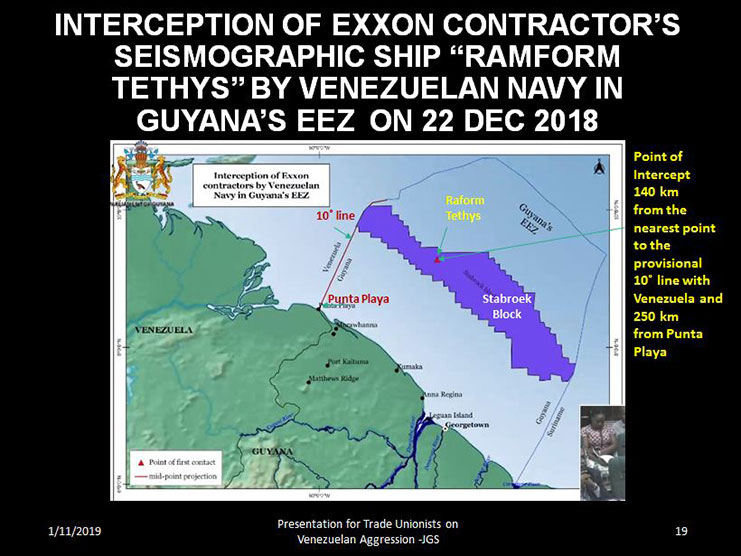— Guyanese must be very vigilant, says Major-General (ret’d) Joe Singh
SINCE 1966, Venezuela has carried out more than 13 serious acts of aggression towards Guyana with the most recent being the interception and attempted boarding of the Ramform Tethys, Major-General (Ret’d) Joseph Singh said.

Singh at the time was delivering a presentation on “Venezuela’s aggression towards Guyana,” alongside Foreign Affairs Minister Carl Greenidge; former Foreign Affairs Minister Rashleigh Jackson; and former Education, Labour and Regional Development Minister Jeffrey Thomas at a recent symposium organised by the Guyana Trade Union Congress (GTUC).
In presenting a timeline highlighting the various acts of aggression carried out by Venezuela, the retired major-general said shortly after Guyana gained independence from Britain on May 26, 1966, Venezuela moved to occupy part of her territory.
“In September 1966, we had the occupation of Guyana’s territory on Ankoko Island in the Cuyuni River; and then on April 14, 1967, Venezuelan Vice-Consul to Guyana, Leopoldo Talyhardat, influenced a conference of Amerindian chiefs held at Kabakaburi, Pomeroon River, to put forward a joint resolution in favour of joint development by Guyana/Venezuela of the Essequibo region,” he pointed out. The revelation of the 1967 plot resulted in the termination of the service of the then Venezuelan Vice-Consul for interfering in Guyana’s internal affairs.

The next year, 1968, Venezuela’s then President Raul Leoni issued a decree claiming a nine-mile-wide stretch of Guyana’s territorial sea along the Essequibo Coast. That same year, its Foreign Affairs Ministry published a notice in the London Times warning investors.
The Spanish-speaking nation, located west of Guyana, in January 1969 was actively involved in the Rupununi secession attempt. “That started in late 1968 and it culminated on 2nd January, 1969, with the attack on the Lethem Police Station and the killing of policemen and civilians,” Major-General (Ret’d) Singh recalled.
But this was just the tip of the iceberg. “On the eve of our Republic (February 22, 1970), Venezuelan border troops at Ankoko Island shot up the police station and shelled the GDF’s border outpost at Eteringbang,” he recalled.
Between the 1970s and 1980s, Venezuela’s military aircraft carried out illegal over flights of Guyana’s territory, despite a series of objections and protest notes submitted. Additionally, Venezuela objected to investments in the Essequibo such as the Beal Aerospace’s proposed equatorial satellite-launching station on the Waini Coast, and the development of the upper Mazaruni hydropower project.
The seizure of the Tecnik Perdana survey vessel in Guyana’s maritime space (2013); the landing of the Venezuelan opposition party at Eteringbang on August 31, 2013; the Maduro Decree claiming Guyana’s Maritime Space off the Essequibo Coast, which includes oil discoveries in the Stabroek Block (2015); the landing of a Venezuelan military helicopter at Kaikan; and the interception and attempted boarding of the Ramform Tethys (December 22, 2018) are the most recent acts of aggression, the major-general (ret’d) detailed.
SPURIOUS CLAIM
It was explained that the acts of aggression started after Venezuela laid a “spurious” claim to Guyana’s territory – the Essequibo region, although it had accepted for more than half a century the 1899 Arbitral Award.
Putting the issue into context, Major-General (Ret’d) Singh detailed that in February 1897, a Treaty of Arbitration was signed in Washington between Great Britain and Venezuela to determine the boundary between British Guiana (now Guyana) and Venezuela. They had agreed that the Arbitral Award would have been the “full, perfect and final settlement” of the boundaries between the two countries.
There were five arbitrators – two represented Great Britain, nominated by the Judicial Committee of Her Majesty’s Privy Council; and two representatives of Venezuela – the Chief Justice of the USA and a Justice of the Supreme Court of the USA. The four nominees elected the fifth member – a permanent member of the Council of the Ministry of Foreign Affairs of Russia, and that person was elected President of the Tribunal.
“The tribunal met in Paris for 55 sessions and on October 3, 1899, handed down a unanimous award,” Major-General (Ret’d) Singh noted, while also pointing out that a Joint Venezuela/British Mixed Boundary Commission (1901-1905) marked on the ground the boundary defined by the Arbitral Award.
But things went downhill when a memorandum written by Severo Mallet-Prevost was published in 1949. Mallet-Prevost, an international lawyer, who was a junior counsel in the team that presented the Venezuelan case and was later decorated with the Order of the Liberator by the Venezuelan Government, had alleged that the Arbitral Award was the result of a diplomatic deal between Britain and Russia.
STRANGE REQUEST
On February 8, 1944, he dictated the memorandum to Judge Otto Shoenrich but instructed that it not be published until after his death.
“Mallet-Prevost’s memorandum was published in 1949 and has remained the main plank in Venezuela’s contention for re-opening the border issue with Britain from 1962, leading up to Guyana’s independence,” the retired major-general explained.
Venezuela is contending that the Arbitral Award is null and void, and as such is claiming the Essequibo. It has intensified attempts recently at appropriating Guyana’s maritime space off the Essequibo Coast.
Major-General (Ret’d) Singh explained that instead of using a 10-degree line (the line marking the point of equidistance), Venezuela is using a 70-degree line. As such, Venezuela is attempting to appropriate all of Guyana’s maritime space and a portion of Suriname’s.
In painting a better picture of the situation, the retired major-general alluded to the December 22, 2018 interception of the seismic vessel by Venezuela’s navy. Venezuela has alleged that the Ramform Tethys was in its territory, but the seismographic ship was actually in Guyana’s Exclusive Economic Zone (EEZ).
“The point of intercept was 140km from the nearest point to the provisional 10- degree line with Venezuela and 250km from Punta Playa,” he further pointed out.
Weighing in on the issue, Foreign Affairs Minister Greenidge noted that the seismic vessel was actually in the middle of the EEZ.
“That Stabroek Block has in it Liza 1 and Liza. Liza 1 is 86km, a little over 90 miles from Suriname… not from the land, but Suriname’s maritime territory,” he pointed, out while dubbing the claim by Venezuela as absurd.
Jackson, a distinguished statesman, in acknowledging that diplomacy has always been Guyana’s first line of defence, said the country must remain vigilant, especially at a time when Venezuela is expanding its claim to the country’s territory and maritime space.
“We have to be active day and night, continuously in the diplomatic field, selling the issue on Guyana’s behalf. There is no let up, there is no slackness, there could be no moment of weakness in that campaign,” he said.
Guyana has turned to the International Court of Justice (ICJ) to confirm the legal validity and binding effect of the 1899 Arbitral Award regarding the boundary between Guyana and Venezuela. The ruling of the court would be final.





.jpg)








